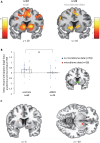Gut microbiome in ADHD and its relation to neural reward anticipation
- PMID: 28863139
- PMCID: PMC5581161
- DOI: 10.1371/journal.pone.0183509
Gut microbiome in ADHD and its relation to neural reward anticipation
Abstract
Background: Microorganisms in the human intestine (i.e. the gut microbiome) have an increasingly recognized impact on human health, including brain functioning. Attention-deficit/hyperactivity disorder (ADHD) is a neurodevelopmental disorder associated with abnormalities in dopamine neurotransmission and deficits in reward processing and its underlying neuro-circuitry including the ventral striatum. The microbiome might contribute to ADHD etiology via the gut-brain axis. In this pilot study, we investigated potential differences in the microbiome between ADHD cases and undiagnosed controls, as well as its relation to neural reward processing.
Methods: We used 16S rRNA marker gene sequencing (16S) to identify bacterial taxa and their predicted gene functions in 19 ADHD and 77 control participants. Using functional magnetic resonance imaging (fMRI), we interrogated the effect of observed microbiome differences in neural reward responses in a subset of 28 participants, independent of diagnosis.
Results: For the first time, we describe gut microbial makeup of adolescents and adults diagnosed with ADHD. We found that the relative abundance of several bacterial taxa differed between cases and controls, albeit marginally significant. A nominal increase in the Bifidobacterium genus was observed in ADHD cases. In a hypothesis-driven approach, we found that the observed increase was linked to significantly enhanced 16S-based predicted bacterial gene functionality encoding cyclohexadienyl dehydratase in cases relative to controls. This enzyme is involved in the synthesis of phenylalanine, a precursor of dopamine. Increased relative abundance of this functionality was significantly associated with decreased ventral striatal fMRI responses during reward anticipation, independent of ADHD diagnosis and age.
Conclusions: Our results show increases in gut microbiome predicted function of dopamine precursor synthesis between ADHD cases and controls. This increase in microbiome function relates to decreased neural responses to reward anticipation. Decreased neural reward anticipation constitutes one of the hallmarks of ADHD.
Conflict of interest statement
Figures





References
-
- Faraone SV, Asherson P, Banaschewski T, Biederman J, Buitelaar JK, Ramos-Quiroga JA, et al. Attention-deficit/hyperactivity disorder. Nature reviews disease primers. 2015:15020 doi: 10.1038/nrdp.2015.20 - DOI - PubMed
-
- Faraone SV, Glatt SJ. A comparison of the efficacy of medications for adult attention-deficit/hyperactivity disorder using meta-analysis of effect sizes. The Journal of clinical psychiatry. 2010;71(6):754–63. doi: 10.4088/JCP.08m04902pur . - DOI - PubMed
-
- Knutson B, Gibbs SE. Linking nucleus accumbens dopamine and blood oxygenation. Psychopharmacology. 2007;191(3):813–22. doi: 10.1007/s00213-006-0686-7 . - DOI - PubMed
-
- Scheres A, Milham MP, Knutson B, Castellanos FX. Ventral striatal hyporesponsiveness during reward anticipation in attention-deficit/hyperactivity disorder. Biological psychiatry. 2007;61(5):720–4. doi: 10.1016/j.biopsych.2006.04.042 . - DOI - PubMed
-
- Strohle A, Stoy M, Wrase J, Schwarzer S, Schlagenhauf F, Huss M, et al. Reward anticipation and outcomes in adult males with attention-deficit/hyperactivity disorder. NeuroImage. 2008;39(3):966–72. doi: 10.1016/j.neuroimage.2007.09.044 . - DOI - PubMed
MeSH terms
Substances
Grants and funding
LinkOut - more resources
Full Text Sources
Other Literature Sources
Medical

